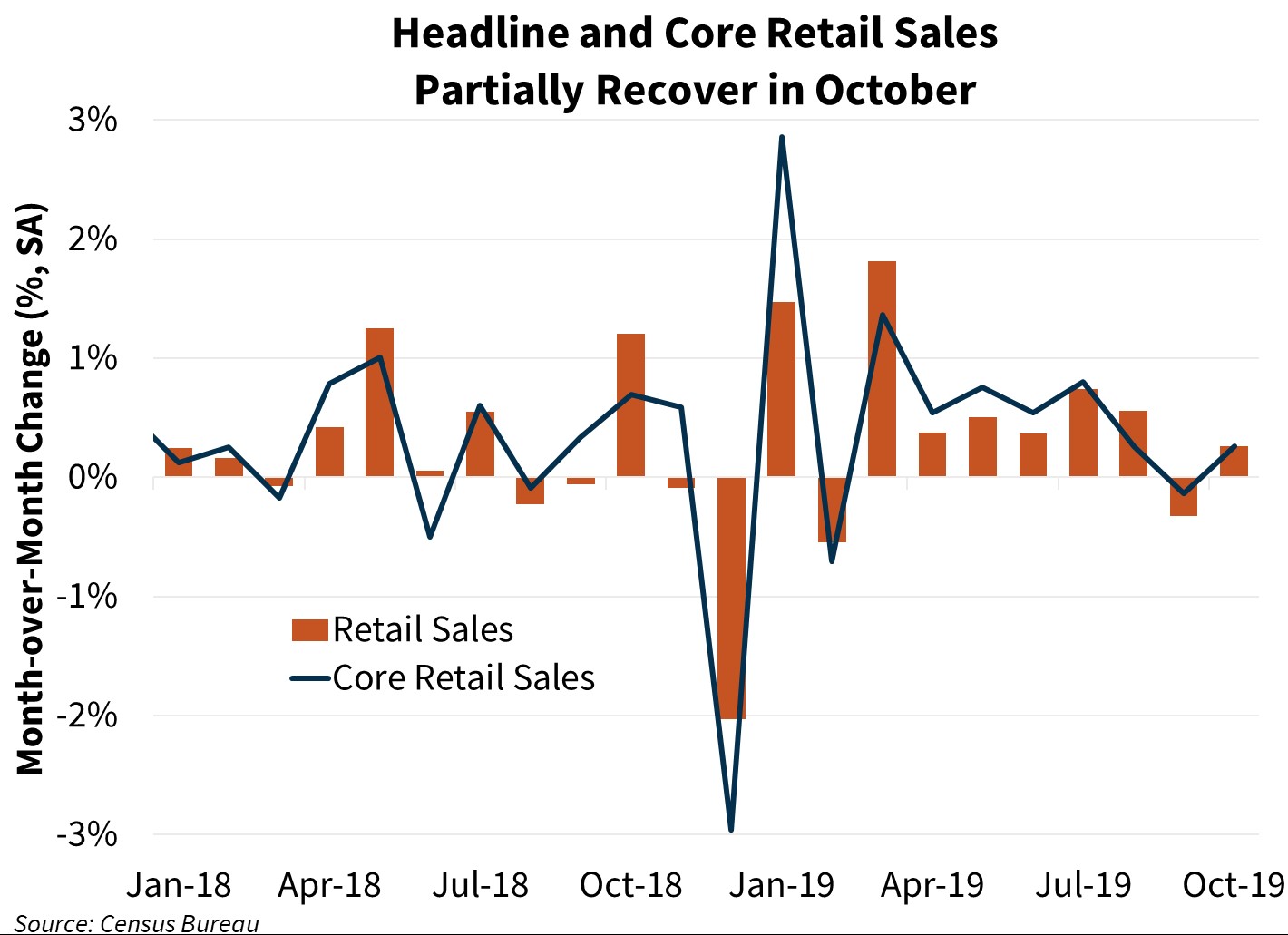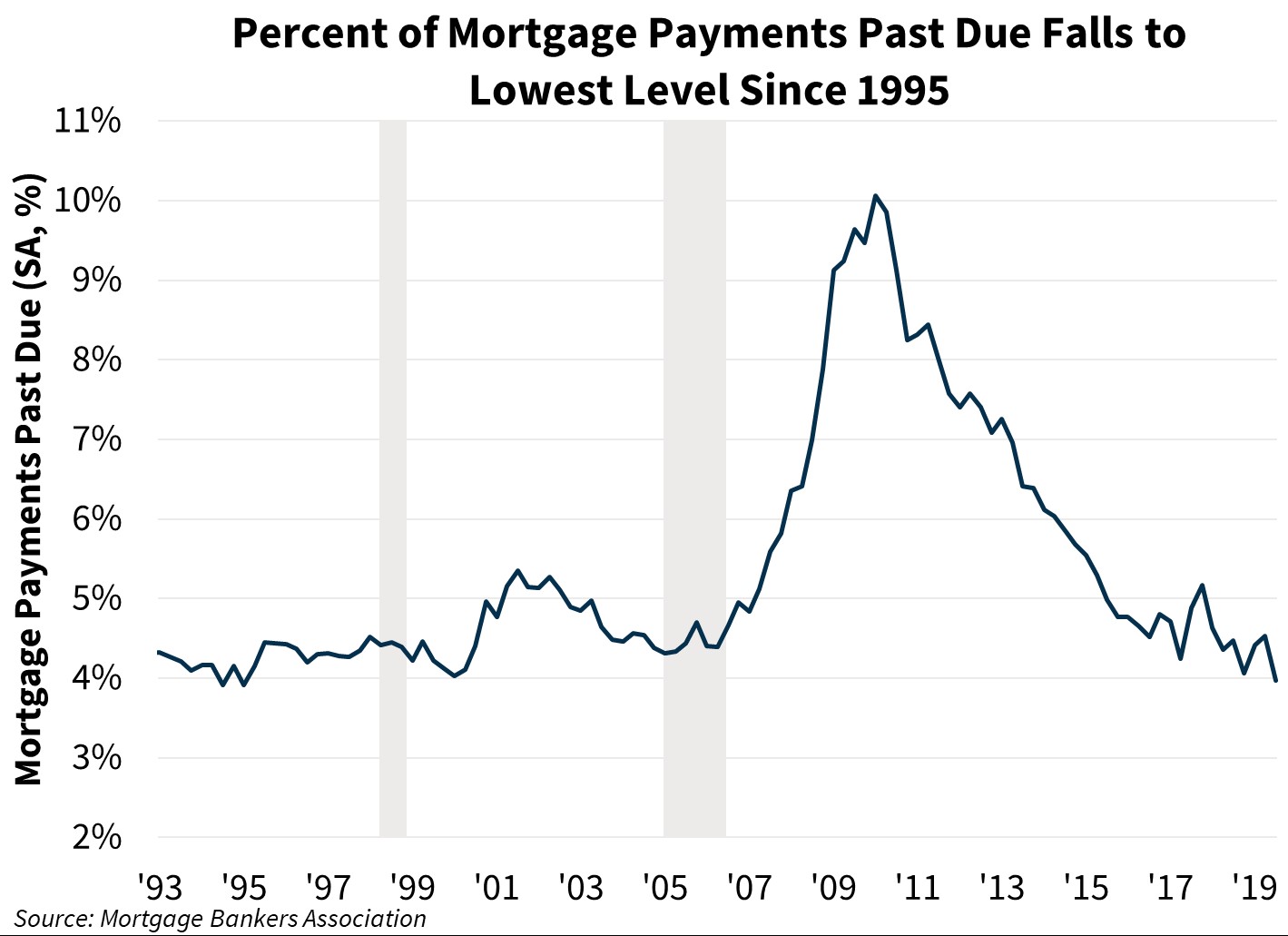Retail Sales Rise Consistent with Strong, but Slowing, Consumer Spending
Key Takeaways
- Retail sales increased in October, recovering partially from a decline in September. While sales at gas stations drove a large portion of growth, core retail sales (excluding food, auto, building supplies, and gas stations) still improved driven by strength in non-store retailers and sales at general merchandise stores. On a less positive note, sales at building supply stores fell for the second month in a row, and sales at furniture and appliance stores posted the largest decline since December 2018.
- The Consumer Price Index (CPI) rose in October, driven by the largest monthly increase in energy prices since April. On an annual basis, headline CPI growth accelerated slightly to 1.8 percent, though it remains below the Fed’s two-percent symmetric target. From a year ago, core CPI (excluding food and energy) growth decelerated slightly for the first time since May.
- Industrial production fell in October for the second month in a row with all three components declining. Decreased output in the manufacturing sector was driven partially by a sharp decline in the output of automotive parts, resulting from the General Motors strike and should be a temporary occurrence now that the strike has ended; excluding motor vehicles, manufacturing output fell only 0.1 percent. Utility output posted the largest decrease since June, which could be attributed to unusually warm October weather and planned power outages in California by Pacific Gas and Electric. The decline in mining output was consistent with a fall in oil prices, which suppresses drilling activity.
- The Mortgage Bankers Association National Delinquency Survey showed that the delinquency rate for mortgage loans on one-to-four-unit residential properties fell in the third quarter to the lowest level since Q1 1995, while the serious delinquency rate (percent of loans that are at least 90 days past due or in the process of foreclosure) ticked down to its lowest level since Q3 2000. Delinquency rates at cyclical lows highlight the positive effects of a strong labor market.
Forecast Impact
The partial recovery in retail sales in October supports our expectation of slowing but continued growth in consumer spending in the fourth quarter. However, the decrease in sales at building supply stores for the second month in a row suggests a decline in residential improvement spending in the beginning of the fourth quarter. Industrial production fell for the second month in a row in October, though the drop was primarily due to transient factors such as the GM strike and unusually warm weather, which should reverse with the conclusion of the strike and the current “arctic blast” experienced by much of the country, reinforcing our view of weak-but-positive business fixed investment in the fourth quarter.


Details on Key Takeaways and Other Releases
- Retail sales rose 0.3 percent in October, according to the Census Bureau, driven by growth at gas stations (1.1 percent), grocery stores (0.4 percent), and non-store retailers (0.9 percent). Excluding sales at vehicle dealers, sales rose 0.2 percent. Sales at furniture and appliance stores fell by 0.7 percent. Core retail sales also rose 0.3 percent in October. From a year ago, both headline and core retail sales increased, rising 3.1 percent and 4.2 percent, respectively.
- The Consumer Price Index rose 0.4 percent in October, driven by a 2.7 percent increase in energy prices. Core CPI grew 0.2 percent. From a year ago, headline CPI increased by 1.8 percent, a tenth faster than in September, while core CPI rose by 2.3 percent, a tenth slower than in September.
- Industrial production, a gauge of output in the manufacturing, utility, and mining sectors, fell 0.8 percent in October, according to the Federal Reserve Board. The manufacturing component fell 0.6 percent, and the mining component fell 0.7 percent, while the utilities component dropped 2.6 percent. On a year-over-year basis industrial production fell 1.1 percent in October. Capacity utilization fell 0.8 percentage points to 76.7 percent.
- The Mortgage Bankers Association National Delinquency Survey for Q3 2019 showed that the delinquency rate for mortgage loans on one-to-four-unit residential properties dropped 56 basis points to a seasonally adjusted rate of 3.97 percent of all loans outstanding. The percentage of loans on which foreclosure actions were started dipped 4 basis points to 0.21 percent. The survey showed that the serious delinquency rate (the percent of loans that are 90 days or more past due in the process of foreclosure, not seasonally adjusted) fell 14 basis point from the prior quarter to 1.81 percent, 32 basis points below the rate from a year ago.
Ricky Goyette
Economic and Strategic Research Group
November 15, 2019
Opinions, analyses, estimates, forecasts and other views of Fannie Mae's Economic and Strategic Research (ESR) Group included in these materials should not be construed as indicating Fannie Mae's business prospects or expected results, are based on a number of assumptions, and are subject to change without notice. How this information affects Fannie Mae will depend on many factors. Although the ESR group bases its opinions, analyses, estimates, forecasts and other views on information it considers reliable, it does not guarantee that the information provided in these materials is accurate, current or suitable for any particular purpose. Changes in the assumptions or the information underlying these views could produce materially different results. The analyses, opinions, estimates, forecasts and other views published by the ESR group represent the views of that group as of the date indicated and do not necessarily represent the views of Fannie Mae or its management.
